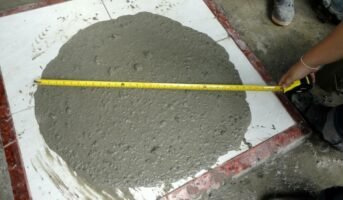The final product of a concrete mix is determined by the proportion of cement, micro grit sand, rough aggregate gravel, and groundwater in a mixture. The material’s blended patterns and architecture type are considered while determining these mixing ratios.
The fundamental goal of concrete mix is to choose small and fine aggregates in such a proportion to obtain a thick compound with the lowest level of cavities using the least quantity of cement. The type of work, quality, the load being placed on the newly created structure, and the weather all influence the choice of concrete mix.
All about Know the varieties of cement and their uses
Types of concrete mix ratio
The strength and durability of concrete majorly depend on the mix ratio used. The various types of concrete mix ratios are:
- Nominal concrete mix ratio: Standard arbitrary proportions of concrete ingredients are used in the nominal mix concrete.
- Standard concrete mix ratio: This type of concrete mix is mostly used in general construction. The proportions are one part cement, two parts sand and four parts coarse materials.
- Design mix ratio for concrete: In this type of concrete mix, the performance of concrete is determined by the designer, while the ratio is usually fixed by the concrete manufacturer.
Concrete mix ratio: Measurement of the concrete mix
The proportioning of the concrete process involves choosing the appropriate amounts of cement and fine and coarse aggregates for the concrete mix. According to the proportioning aggregate principle, the spaces between large particles will be filled by the smaller particle. A minimum amount of cement per volume unit is needed for a properly proportioned concrete mix.
See also: All about sand replacement method
A concrete mix of M25 grade:
M25-grade concrete is produced by mixing cement, sand, and aggregates in the amounts listed below. In concrete of the M25 grade, the following cement ratios are used:-
- Cement in one part
- Sand or other fine aggregates in one part
- Coarse aggregate in two parts, and
- The necessary amount of water
M = mix and 25 = the concrete’s obtained compressive strength after 28 days, expressed in MPa, that grade of concrete is known as M25.
see also about the micro concrete
Concrete mix ratios for nominal concrete
It used to be that the amounts of clinker, fine aggregates, and pozzolana were stated in the concrete standards. Nominal mixes contain a predetermined ratio of cement to aggregate to ensure proper strength. In most cases, insignificant blends are straightforward and have a margin of power above what is provided. The nominal concrete for a given workability has a wide range of strengths due to the variable mix constituents. For M15, the nominal mix ratio is 1:2:4; for M20, it is 1:1.5, etc.
known about Where and how to use concrete walls?
Standard mix ratio
Specific concrete requirements require that cement, sand, aggregates, and water be used in these ratios. Nominal mixes are regular mixtures with a fixed cement, sand, and aggregate ratio, guaranteeing sufficient strength.
Standard blends are straightforward and, in most cases, have an additional margin of strength. But the nominal power of concrete for a given workability varies significantly due to the variety of the mixed materials. In most cases, small-scale buildings use this standard mix ratio. This mix has pre-fixed and sets nominal concrete mix ratios and concrete element proportions.
known about Grades of concrete
The high-strength concrete mix ratio
These proportions of cement, sand, aggregate, and water are specified in concrete’s high-strength mix ratio requirements. Nominal mixes refer to stable cement, fine aggregate sand, and aggregate ratios that produce high-strength combinations and guarantee enough strength. High-strength mixtures make things simple and, under typical circumstances, have a margin of power above what is required. But the nominal concrete for a given workability has a wide range of forces since the mixed material varies.
all about modulus of elasticity formula
Design mixture ratio

Source: Pinterest
High-rise construction uses concrete that has a design mix. After examining the qualities of each component of concrete, an engineer determines the mix ratios for this sort of mix. When choosing the design mix ratio, the fineness modulus and specific gravity of cement are examined in the lab.
No pre-fixed ratio exists, and substances are bulked based on weight. Concrete grades greater than M25, as shown in the table, are included in the design mix. The ratios chosen by the designer are referred to as the “design mix”.
all about the What is concrete, its types and composition
Varying concrete grades:
Concrete mix ratios vary depending on the grade of concrete, which also varies depending on the substantial mix proportions. The following proportions for the concrete mix are specified in IS 456:2000.
| Type of concrete | Concrete grade | Mix ratio | Characteristic compressive strength of concrete @28Days in N/mm2 |
| Ordinary concrete | M5
M7.5 M10 M15 M20 |
1:5:10
1:4:8 1:3:6 1:2:4 1:1.5:3 |
5 N/mm2
7.5 N/mm2 10 N/mm2 15 N/mm2 20 N/mm2 |
| Standard Concrete | M25
M30 M35 M40 M45 M50 |
1:1:2
Design mix Design mix Design mix Design mix Design mix Design mix |
25 N/mm2
30 N/mm2 35 N/mm2 40 N/mm2 45 N/mm2 50 N/mm2 |
| High Strength Concrete | M55
M60 M65 M70 |
Design mix
Design mix Design mix Design mix |
55 N/mm2
60 N/mm2 65 N/mm2 70 N/mm2 |
known about: specific gravity of cement
Concrete mix ratio: Benefits of using a concrete mix

Source: Pinterest
- Quality of a mix: Since the ratio of the quantity of the components is accurate, the concrete’s quality is better than the little mix, allowing for the achievement of the requisite strength.
- With the right amount of cement, constructors can create concrete with the requisite strength. Reducing the heat of hydration lowers the project’s cost, yields a more affordable concrete mix, and helps prevent shrinkage cracks.
- Economical: While the design mix provides a defined quantity of cement and other materials, the nominal mix, which lacks a fixed ratio for material ratio, occasionally suggests adding more clay. That distinction, then. In this way, the differential contributes to cost savings of up to 15%–20%.
- The desired concrete attributes, including workability, strength, durability, and setting time, can be obtained using the mix design.
FAQs
What does the IS code for concrete mix design mean?
The Bureau of Indian Standards established a specific process for designing concrete mix proportioning. The IS 10262: 2019 standard covers the concrete mix design calculation method.
What is the mixture ratio for solid concrete?
The components typically need to be combined in the ratio 1:2:3:0.5 to produce concrete with the highest strength. In that ratio, there is 1 component of cement, two parts sand, three parts gravel, and 0.5 part water.
Why is water essential in the concrete mix?
Concrete permeability and encapsulation efficiency will improve as the moisture content rises.
| Got any questions or point of view on our article? We would love to hear from you. Write to our Editor-in-Chief Jhumur Ghosh at [email protected] |
Housing News Desk is the news desk of leading online real estate portal, Housing.com. Housing News Desk focuses on a variety of topics such as real estate laws, taxes, current news, property trends, home loans, rentals, décor, green homes, home improvement, etc. The main objective of the news desk, is to cover the real estate sector from the perspective of providing information that is useful to the end-user.
Facebook: https://www.facebook.com/housing.com/
Twitter: https://twitter.com/Housing
Email: [email protected]











